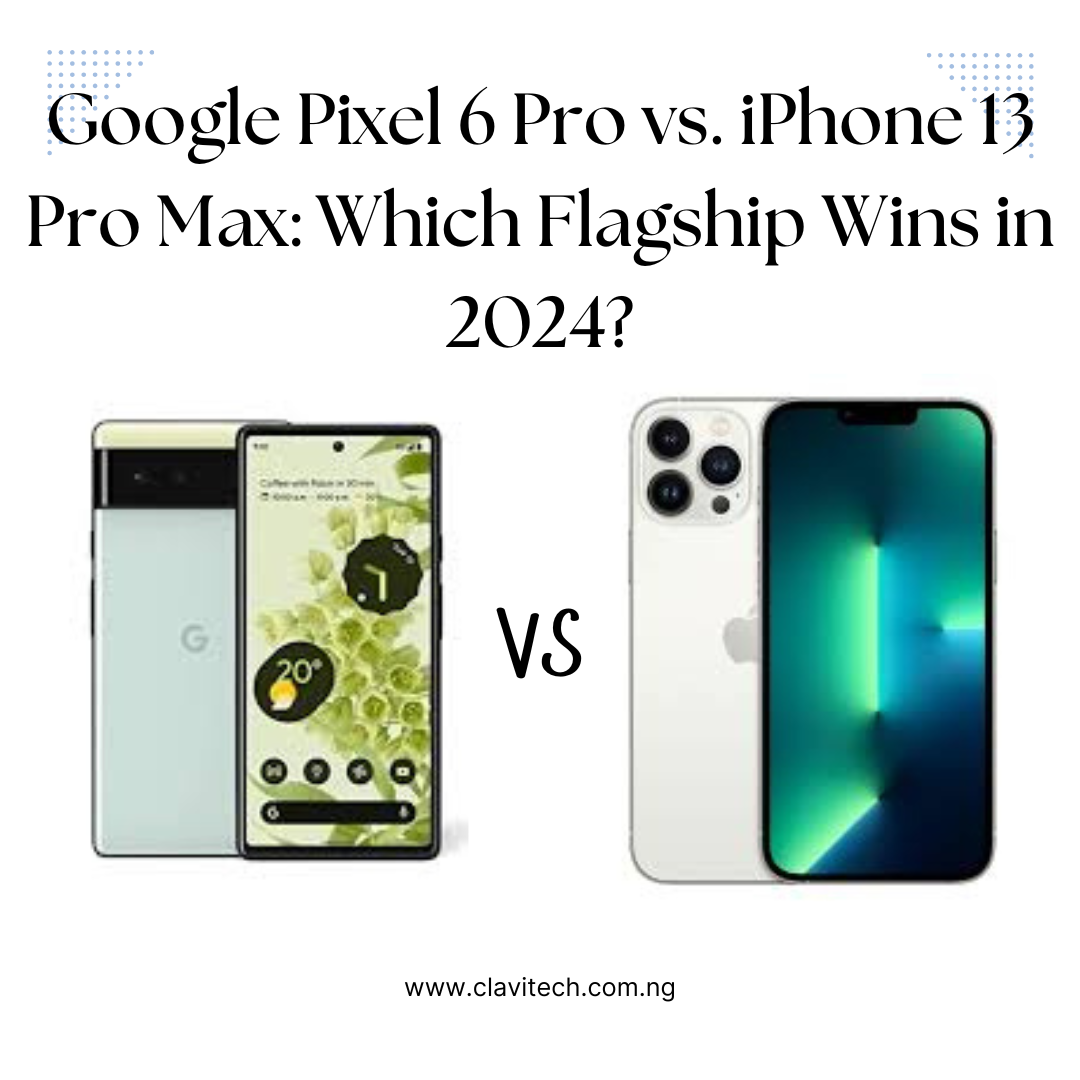The Google Pixel 6 Pro and iPhone 13 Pro Max have gained significant attention for their impressive features, design, and camera capabilities. Both are flagship models, offering cutting-edge technology and sleek designs. But which one truly stands out for everyday use, photography, battery life, and performance? In this in-depth comparison, we’ll examine every key aspect of these two smartphones to help you determine which flagship device suits your needs best.
1. Design and Build Quality
The design language of each phone is distinctive, catering to different aesthetic preferences.
Google Pixel 6 Pro: Google has revamped the Pixel design with a unique two-tone color scheme and a striking camera bar that runs horizontally across the back. The device has a Gorilla Glass Victus front and back, coupled with an aluminum frame, offering durability with a modern look.
iPhone 13 Pro Max: Apple continues its iconic design with flat edges, a polished stainless steel frame, and a Ceramic Shield front. The colors—Graphite, Gold, Silver, and Sierra Blue—exude a premium feel, making it instantly recognizable as an Apple device.
2. Display Comparison
Both the Pixel 6 Pro and iPhone 13 Pro Max offer large, immersive displays, each with unique characteristics.
Google Pixel 6 Pro: It sports a 6.7-inch LTPO OLED display with a 3120 x 1440 resolution. With a 120Hz refresh rate, the display feels smooth and fluid, ideal for gaming and multimedia use. Google’s color calibration also provides vibrant colors and deep contrasts.
iPhone 13 Pro Max: The iPhone’s 6.7-inch Super Retina XDR OLED display boasts a resolution of 2778 x 1284, which, while slightly lower than the Pixel, provides incredible color accuracy and brightness. The ProMotion 120Hz display adapts refresh rates based on activity, optimizing battery life while keeping everything smooth.
3. Camera Capabilities
Camera quality is a critical factor for many smartphone users, and both phones come with impressive setups.
Google Pixel 6 Pro: The Pixel 6 Pro features a 50MP wide lens, 48MP telephoto lens with 4x optical zoom, and a 12MP ultrawide sensor. Known for its advanced computational photography, Google’s camera software adds features like Magic Eraser, Real Tone, and improved Night Sight, delivering exceptional low-light performance and clarity.
iPhone 13 Pro Max: Apple’s triple-lens setup includes a 12MP wide, 12MP telephoto with 3x optical zoom, and a 12MP ultrawide lens. The iPhone 13 Pro Max stands out for its Cinematic Mode, which allows you to record videos with a shallow depth of field. Apple’s Night Mode is also highly effective across all lenses.
4. Performance and Software Experience
The Pixel 6 Pro and iPhone 13 Pro Max each boast powerful processors but have different software ecosystems.
Google Pixel 6 Pro: Running on Google’s custom Tensor chip, the Pixel 6 Pro is designed for smooth multitasking and advanced AI-driven features. Android 12 on the Pixel offers a clean, customizable interface with Material You, which adjusts the color palette based on your wallpaper.
iPhone 13 Pro Max: The A15 Bionic chip in the iPhone 13 Pro Max is highly optimized, ensuring seamless performance and efficiency. Coupled with iOS 15, Apple’s software ecosystem emphasizes privacy and stability. The iPhone’s interface is intuitive, especially for users already invested in Apple’s ecosystem.
5. Battery Life and Charging Options
Battery longevity and charging speed are essential for users who rely on their phones all day.
Google Pixel 6 Pro: It packs a 5003mAh battery that provides enough power for a full day’s use. The Pixel supports 30W fast charging and 23W wireless charging, though the full charger is sold separately.
iPhone 13 Pro Max: The 4352mAh battery on the iPhone 13 Pro Max offers some of the best battery life on an iPhone. It supports 20W fast charging and Apple’s 15W MagSafe wireless charging, though charging times are slightly slower than the Pixel.
6. Additional Features and Software Updates
Both devices offer unique extras that may sway certain users.
Google Pixel 6 Pro: Google promises up to five years of security updates for the Pixel 6 Pro, ensuring long-term support. Pixel-exclusive features like Hold for Me, Direct My Call, and live translation are beneficial for frequent travelers and daily convenience.
iPhone 13 Pro Max: Apple’s iOS updates generally support devices for many years, often longer than Android devices. Features like FaceTime, Apple’s Fitness+ integration, and seamless interaction with other Apple devices make it a preferred choice for those in the Apple ecosystem.
7. Price Comparison and Overall Value
When deciding between these two flagships, cost can be a deciding factor.
Google Pixel 6 Pro: The Pixel 6 Pro starts at [insert starting price] for 128GB of storage. Google often offers discounts or trade-in deals, making it more affordable at times than the iPhone.
iPhone 13 Pro Max: The starting price for the iPhone 13 Pro Max is higher than the Pixel 6 Pro, though Apple’s phones often hold their resale value well. Available in multiple storage options, it caters to users who may need larger storage for apps and media.
Conclusion
Both the Google Pixel 6 Pro and iPhone 13 Pro Max are excellent choices, but each shines in different areas. If you’re a fan of Android, appreciate Google’s software innovations, or value a strong camera system with unique AI-powered features, the Pixel 6 Pro is an excellent choice. On the other hand, the iPhone 13 Pro Max offers superior battery life, software integration, and a smooth user experience, especially for those already using Apple’s ecosystem.
Ultimately, both phones showcase the best of Google and Apple, making either device a worthy investment in 2024

